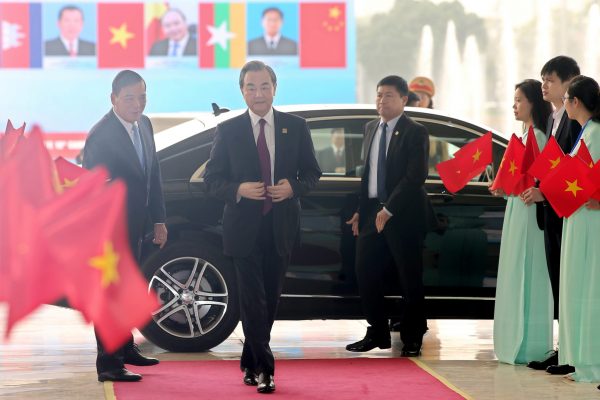This strategy is clearly illustrated by the stellar rise of the Lancang-Mekong Cooperation (LMC), an ambitious Chinese initiative that involves the six countries of the Mekong sub-region: China, Laos, Myanmar, Thailand, Cambodia and Vietnam. At the first LMC summit in 2016, China promised 10 billion RMB (US$1.6 billion) in preferential loans and US$10 billion in credit to the five Mekong countries, while the next year saw a new set of government concessional loans with a total value of US$1.1 billion and US$5 billion in credit for 45 ‘early-harvest’ projects under the mechanism.
With such a huge investment, China does not see the LMC as just an instrument to settle quarrels over water. As the LMC’s first five-year plan revealed, its priority areas range from connectivity and cross-border economic cooperation to agriculture, poverty reduction and even media exchange. Under the theme of this year’s summit, it wants to build ‘a community of shared future of peace and prosperity’. Although these prospects are far from being realised, the LMC can be a serious channel for Beijing to meddle in Southeast Asian affairs at a time when ASEAN is fragmented on a wide range of issues.
Under the LMC, China has made financial commitments for a whopping 132 projects. The first two years (2018 and 2019) will be the ‘foundation-laying stage’, with a focus on small- and medium-sized projects, while the years from 2020 to 2022 will be the ‘expansion stage’. Beijing has not publicly provided the list of the projects that received funding under the LMC mechanism, making these subject to bilateral agreements like the first summit’s early harvest projects. In addition, Chinese Premier Li Keqiang’s open wish of pushing the cooperation with Mekong countries into ‘the age of high-speed rail’ raises questions about China’s intended direction for the LMC.
It is impossible to discuss the LMC without putting it into the context of the Belt and Road Initiative (BRI). The Mekong sub-region represents a key area for the BRI. The so-called ‘signature projects’ of the LMC, such as the Kunming–Bangkok road, China–Laos railway and Long Jiang Industrial Park (in Vietnam), are included in the BRI framework. In addition, as noted at the second LMC summit in January 2018, most of the financial resources for LMC projects will come from China, either through the LMC special fund or the Asian Infrastructure Investment Bank (AIIB) and the Silk Road Fund. The link with China’s ‘initiative of the 21st century’ indicates that the LMC is a part of a bigger bid by Beijing to seek a leadership role in the region.
The significance of the LMC is not about investment, which is still small by Chinese standards. The LMC is the first Chinese-built Southeast Asian institution. A rising superpower needs either to dominate the current institutions or to create a new order of its own. With the AIIB, the BRI, the Shanghai Cooperation Organization and now the LMC, it seems that China is taking the latter option.
An institution with Chinese characteristics might not necessarily be a bad one, but there are nevertheless several reasons for Mekong countries to worry.
First, the relations between China and the Mekong countries are complicated. While Vietnam has stubbornly resisted China’s attempts to control the South China Sea, other countries like Laos, Cambodia, Myanmar and Thailand seem to have smoother relations with Beijing. The Chinese infrastructure spree in the region within the framework of the LMC and the BRI seems to meticulously take note of that. Up to now, all major BRI projects neglect Vietnam. Scholars and policymakers in the country have voiced concerns about the possible ‘infrastructure trap’ that could disable Vietnam’s long-term development path. This ‘carrot and stick’ approach cannot be seen to promote ‘win-win’ scenarios as Beijing claims but instead is a tool to force disobedient countries to bend their will to the Chinese way.
Second, it goes without saying that the only free cheese is in the mousetrap. Eight countries that have signed up to the BRI are now believed to be in danger of falling into China’s ‘debt trap’, which, according to former US secretary of state Rex Tillerson, could undercut their sovereignty and harm their long-term sustainable growth.
Third, the LMC and BRI frameworks are largely opaque, non-binding and subject to interpretation. This means a superpower with overwhelming economic, military and political advantages like China will have an upper hand in any negotiation on the details. In addition, even Beijing does not solely trust cooperation: in parallel to LMC, China continues its increasing investment along the Mekong with mega dams and navigation channels.
China has already built seven mega dams, and more than 20 are still under construction or planned in Yunnan, Tibet and Qinghai. Consequently, no country in the lower Mekong region is brave enough to stand up when their destiny depends too much on Beijing’s goodwill. In 2016, facing the worst drought in 90 years, Vietnam had to request China to release water from its mega dams to quench water shortages.
China’s road to becoming a superpower in the 21st century inevitably requires it to go south to Southeast Asia, making its way through Mekong countries. In contrast to the United States, China has a permanent national interest in the region and will be unlikely to retreat. Taking this into consideration, Mekong countries need a more nuanced approach to Chinese offers in order to benefit from their infrastructure spending without submitting to conditions that might be harmful to their development in the long run.
Nguyen Khac Giang is the lead political researcher at the Vietnam Institute for Economic and Policy Research (VEPR) at the Vietnam National University in Hanoi.


The Mekong countries traditionally see Vietnam as a regional bully. So cozying up to China also has a geopolitical dimension in addition to an economic one.